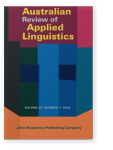A contrastive analysis of letters to the editor in Chinese and English
This study examines similarities and differences between English and Chinese letters to the editor on newspapers from the perspectives of contrastive rhetoric and genre theory. Generic structures, rhetorical structures, and logico-semantic relations of 20 letters to the editor (10 in Chinese and 10 in English) were examined in detail. Findings of this study include: 1) there was often an editor’s preview (i.e. a brief introduction to the letters written by editors) in Chinese letters to the editor in this study; 2) Appeals to values and needs were used to support their claims in Chinese letters to the editor, whereas English writers employed evidence to do this. The study suggests that ‘evidence’ and ‘appeals to values and need’ are deeply rooted in the two cultures and societies, and hence find their place in the writers’ texts; 3) consequential and additive logico-semantic relations were often used in both the Chinese and the English letters, however, consequential relations were more frequently used in the Chinese letters to the editor than in the English ones. All the findings are discussed in relation to the different writing styles and the socio-cultural values of each culture.
References
Allwright, D. & Bailey, K. M.
(
1991)
Focus on the language classroom. Cambridge: Cambridge University Press.

Butt, D., Fahey, R., Spinks, S., & Yallop, C.
(
2000)
Using Functional Grammar. (2
nd ed,) Sydney: National Centre for English Language Teaching and Research, Macquarie University.

Cahill, D.
(
1999)
Contrastive rhetoric, Orientalism, and the Chinese second language writer. PHD dissertation unpublished Chicago: University of Illinois.

Cai, G.
(
1993)
Beyond bad writing: Teaching English composition to Chinese ESL students. Paper presented at the college composition and communication conference, San Diego, CA.
Connor, U.
(
1996)
Contrastive rhetoric: Cross-cultural aspects of second language writing. Cambridge: Cambridge University Press.


Connor, U.
(
2002)
New directions in contrastive rhetoric. TESOL Quarterly 36(4). 493-510

Gerot, L. & Wignell, P.
(
1994)
Making Sense of Functional Grammar. Gold Coast, QSL: AEE Publishing.

Halliday, M. A. K.
(
1994)
An introduction to functional grammar. (2
nd ed). London: Edward Arnold

Hamp-Lyons, L. & Zhang, B. W.
(
2001)
World Englishes: Issues in and from academic writing assessment In
Flowerdew &
Peacock (Ed.)
Research perspectives on English for academic purposes (pp. 101-116). Cambridge: Cambridge University Press.


Ho, D. Y., & Chiu, C.
(
1994)
Component ideas of individualism, collectivism, and social organization: An application in the study of Chinese culture. In
U. Kim,
H. Triandis,
C. Kagiteibasi,
S. Choi, &
G. Yoon (Eds.).
Individualism and collectivism. Thousand Oaks, CA: Sage.

Hoey, M.
(
1983)
On the surface of discourse. London: George Allen and Unwin.

Kaplan, R. B.
(
1966)
Cultural thought patterns in intercultural education.
Language learning 161:1-20.


Kaplan, R. B.
(
1972)
The anatomy of rhetoric: Prolegomena to a functional rhetoric. Philadelphia:
Center for Curriculum Development.

Kaplan, R. B.
(
1987)
Cultural thoughts patterns revisited. In
U. Connor &
R.B. Kaplan. (Ed)
Writing across language: Analysis of L2 Text (pp. 9-21). Reading, MA: Addison-Wesley.

Kaplan, R. B.
(
1988)
Contrastive rhetoric and second language learning: Notes toward a theory of contrastive rhetoric. In
A. C. Purves (Ed.),
Writing across languages and cultures: Issues in contrastive rhetoric (pp. 275-304). Newbury Park, CA: Sage.

Kaplan, R. B.
(
2000)
Contrastive rhetoric and discourse analysis: Who writes what to whom? When? In what circumstances? In S. Sarangi &
M. Coulthard (Ed.),
Discourse and social life. London: Longman.

Kirkpatrick, A.
(
1995)
Are they really so different? The ‘Chinese’ genre of university entrance essays.
Open Letter. 5(2): 43-52.

Knapp, P. & Watkins, M.
(
1994)
Context-text-grammar. Sydney: Text Productions.

Leki, I.
(
1991)
Twenty-five years of contrastive rhetoric: text analysis and writing pedagogies.
TESOL Quarterly 25(1): 123-143.


Martin, J. R.
(
1993)
Genre and literacy-modelling context in educational linguistics.
Annual Review of Applied Linguistics 131: 141-172.


Martin, J. R.
(
1994)
Macro-genres: The ecology of the page.
Network 211:29-52.

Martin, J. R.
(
1997)
Analysing genre: functional parameters. In
Frances Christie &
J. R. Martin (Ed.).
Genre and institutions (pp.3-39). London and New York: Continuum.

Martin, J. R.
(
2001)
Language, register and genre. In
A. Burns &
C. Coffin (Ed.).
Analysing English in a global context (pp. 149-166). London and New York: Routledge, Taylor & Francis Group.

Martin, J. R., Christie, F., & Rothery, J.
(
1987)
Social processes in education: A reply to Sawyer and Watson (and others). In
I. Reid (Ed.),
The place of genre in learning: Current debates (pp. 46-57). Geelong, Australia: Deakin University Press.

Matalene, C.
(
1985)
Contrastive rhetoric: An American teacher in China. College English 47 (8): 789-808.


Rottenburg, A. T.
(
1994)
The structure of argument. Boston: Bedford Books of St. Martin‘s Press.

Scollon, R.
(
1991)
Eight legs and one elbow. Stance and structure in Chinese English compositions. Paper presented at International Reading Association, Second North American Conference on Adult and Adolescent Literacy, Banff.
Taylor, G. & Chen, T.
(
1991)
Linguistic, cultural, and subcultural issues in contrastive discourse analysis: Anglo-American and Chinese scientific texts.
Applied Linguistics 12(3): 319-336.


Zhu, Y.
(
2000)
Structural moves reflected in English and Chinese sales letters.
Discourse Studies 2(4): 525-548.

Cited by
Cited by 3 other publications
Al-Ali, Mohammed Nahar & Badra Hadj Djelloul
Ashraf, Hina
2014.
Letters to the editor: A resistant genre of unrepresented voices.
Discourse & Communication 8:1
► pp. 3 ff.

This list is based on CrossRef data as of 29 june 2024. Please note that it may not be complete. Sources presented here have been supplied by the respective publishers.
Any errors therein should be reported to them.
